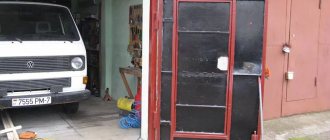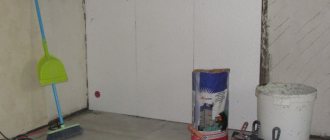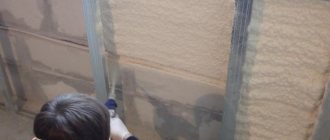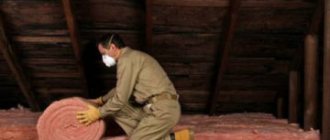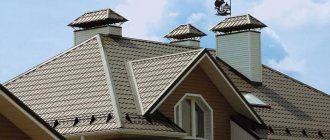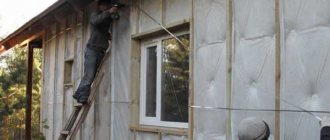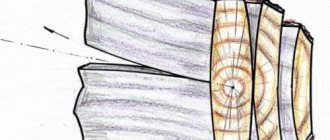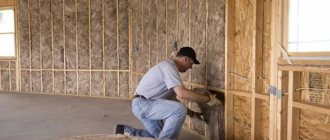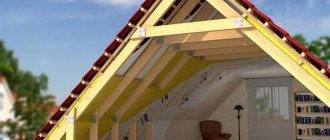Insulating a timber house from the inside is an important job. How to insulate the walls of a log house from the inside to reduce heat loss. How to properly and whether it is possible to insulate a house made of timber inside to avoid destruction. Many people prefer to build houses from timber because it is environmentally friendly and looks beautiful. It also retains heat well. But in Russian frost conditions, such thermal insulation is not always enough. Therefore, we have to resort to more serious insulation of the house. In this article we will figure out how to insulate a house made of timber from the inside so that it is always warm in winter.
Insulating a house made of timber from the inside - choosing a material
First of all, the insulation must be safe. Many people will think that thermal insulation material, first of all, should have poor thermal conductivity. That is, the better the material prevents heat from escaping from the premises, the more priority it has in terms of choice. But that's not true! First you need to pay attention to non-flammability and environmental friendliness.
Imagine that you have chosen good insulation. It is better than other types in terms of thermal insulation characteristics. But you neglected safety.
As a result, the material will release harmful substances. This will have a bad effect on your health. For example, you will periodically have a headache or feel nauseous. The house will be warm, but this will be accompanied by more serious problems. In addition, you need to select a material so that it is light, vapor-tight and does not shrink. Below we will consider all the advantages and disadvantages of insulation and summarize.
Recommendations for carrying out warming measures
To provide a building with a high-quality insulating coating, it is important to follow certain recommendations from experts:
- Purchased insulation for finishing external walls should be stored in a dry place, in packaging, so that moisture suddenly penetrating into it does not affect the performance characteristics of the material.
- The slabs can be secured not only with fasteners, but also in another way. To do this, the sheathing slats are located closer to each other: their width should be 15-20 mm less than the size of the materials used.
And remember that when working with insulating materials, you need to take care of your own safety by wearing goggles, gloves and a respirator.
Preliminary thermal insulation of a timber house
Insulating a house made of timber from the inside requires that you pay attention to three points:
- After construction, the timber shrinks for a year. During this time, no work can be carried out inside the house.
- Linen tow should be installed in the cavity between the logs. This is necessary so that there is not a single crack in the timber. Caulking must be done starting from the bottom. If you start caulking one strip, finish it all the way around the entire perimeter. Only then proceed to the rest.
- It is important to treat the walls. They need to be cleaned of dust and dirt. The walls are treated with antiseptics and fire retardants (substances that protect against fire).
Insulation technology
The walls are insulated in the following sequence:
- Installation of waterproofing;
- Attaching wooden beams. Heat-insulating material is attached to them;
- Insulation;
- Installation of vapor barrier;
- final finishing.
Sometimes “warm” plaster is applied over the insulation. It enhances thermal insulation properties.
Why do you need inter-central insulation?
What benefits does using such insulation provide? Let's look at some key points.
- Linear changes in timber dimensions that occur annually are compensated. This insulation is plastic; it expands when the gap increases, and therefore heat loss is eliminated.
- Protecting the premises from street noise. This characteristic is directly related to the thermal conductivity of the material.
- Increasing the service life of the building. Moist, cold air can penetrate through the cracks, causing moisture to condense on the timber. It takes a long time to dry, and therefore the wood will deteriorate faster. It will begin to rot, mold will appear, and as a result, the strength of the wood will deteriorate (this can even lead to critical deformations of the house). Repairs in this case will be difficult and expensive, and also – it is possible – ineffective.
- Heat saving increases. This point is especially important in view of the permanently rising fuel prices. Sometimes the use of inter-crown insulation makes it possible to do without external wall insulation, and this, again, saves money.
Installation of interventional insulation
Interventional insulation comes in various types
Insulation of floors and roofs
Materials for floor insulation are laid in the following sequence:
- Subfloor
- Waterproofing layer;
- Thermal insulation material;
- Vapor barrier;
- Floor installation.
If you use penoizol as thermal insulation, then it is not necessary to do a vapor barrier. When insulating the roof, you need to observe a number of nuances:
- It is necessary to correctly determine the required thickness of insulation and select the appropriate material. Polystyrene foam is not recommended.
- Hydro- and vapor barrier films are attached overlapping along the horizon.
- The gap for ventilation is made at least 4 cm.
- The roof is covered with perforated soffits.
- Install a ventilated ridge.
Timber as a building material for cottages
Options for timber are divided depending on the shape of the logs and types of joints. Most often, the following types of timber are used in the construction of log structures:
- Planed. The cross-section of the log has a rectangular or square shape. Such timber can be purchased at a low price. But it is unreliable: the logs can become deformed and cracks appear in them. In addition, such timber is susceptible to rotting over time.
- Profiled. The cross-section of the timber does not differ from the previous version. But the surface compatibility of profiled logs is better. With such material it is possible to assemble a structure using the “tenon and groove” technology. Such log houses have no cracks.
- Glued. The timber is assembled using glue. It helps to tightly hold the logs together and protects the wood from microorganisms. These materials are expensive.
What happens to the timber after laying it on top of the heat insulator?
When using vapor-tight heat insulators, the timber absorbs moisture from inside the rooms. The partial pressure inside the wood increases and steam molecules escape to the periphery.
From the open side they again enter the room, and from the outside they accumulate. This exchange process can last for years, but leads to the formation of a water film on the timber and insulation.
Over time, rotting processes begin and fungus begins to multiply, so it is better to use vapor-permeable materials.
Materials for insulating a timber house
There are a huge variety of materials that can be used, we will try to show the advantages and disadvantages of each of them.
Insulation of a house made of timber from the inside - Minvata
This is the most commonly used material for insulating walls in a log house. Advantages:
- Cotton wool weighs little;
- It doesn't burn well. The material will protect the walls from fire;
- High vapor permeability;
- Does not emit harmful substances;
- Does not deteriorate when exposed to microorganisms;
- Mineral wool does not require the attachment of a vapor barrier film.
- The price suits the buyers.
The big disadvantage of mineral wool is skin irritation. Therefore, during finishing work it is necessary to protect all areas of the skin. Basalt wool does not shrink over time and does not absorb moisture. Fiberglass building materials require the installation of vapor and waterproofing and shrink over time. This negatively affects the retention of heat in the room in the future. The mineral wool is laid out in a thick layer. If this is neglected, moisture will accumulate in the material.
Insulation of a house made of timber from the inside - Ecowool
This material is 80% cellulose. But this substance is unsuitable for use for construction purposes. Therefore, ecowool is made with the addition of borax and boric acid. Borax protects the material from ignition. Boric acid prevents the appearance of fungi and bacteria in the material. Advantages of ecowool:
- The insulation absorbs moisture and evaporates it. When absorbing condensate, the material retains its heat-insulating properties.
- Ecowool leaves no cracks.
- This insulation has good sound insulation.
- The material does not release toxic substances into the air.
- Not the cheapest insulation, but cheaper than polyurethane. By the way, ecowool is superior to the previous material in many important indicators
The heat insulator has disadvantages. They concern its installation. Installation requires special equipment. If you perform a wet installation of ecowool, you should wait 2-3 days until the insulation dries.
Insulation of a house made of timber from the inside - polyurethane
The material is saturated with air. And air, as you know, is a poor conductor of heat. Due to this, the foam retains heat in the rooms. Advantages of the material:
- Safe when carrying out insulation work and easy to use;
- When used correctly, it does not affect health during use;
- The insulation performs its function for a long time;
- Foam fills all the cracks;
- The building material protects the timber from the appearance of microorganisms;
- Does not deteriorate when exposed to moisture and steam.
But this insulation has serious disadvantages:
- Polyurethane is highly flammable;
- It is not easy to insulate with this building material. For insulation you will need professional equipment, which is not cheap. It is not advisable to buy it just for once;
- Expensive. This heat insulator is 2-2.5 times more expensive than mineral wool;
- PU releases hydrocyanic acid into the air.
Insulation of a house made of timber from the inside - polystyrene foam
Like previous materials, polystyrene foam is ambiguous, and has pros and cons. But it is worth noting that this is one of the most common materials. Advantages of polystyrene foam:
- Resistant to moisture. There is no need to even use a waterproofing layer;
- The material does not emit harmful substances.
- Polystyrene foam is very light weight. Due to this, it is easy to install.
- Microorganisms do not survive in such insulation, so the material does not rot.
Flaws:
- The insulation burns easily. Even if you treat the foam with fire retardants, there will be no effect.
- Poor vapor permeability.
- Not every adhesive mixture is suitable for this material. It is necessary to select a substance so that it does not contain benzene, dichloroethane and solvents.
- Mouse nests are made in such insulation and insects inhabit them. To avoid this, you need to treat the building material with special substances.
Experts do not recommend using polystyrene foam, because it is difficult to select vapor barrier materials for such insulation. Otherwise, moisture will accumulate between the wood and the insulation. Fungus and microorganisms form in this space.
What kind of insulation should this be?
Any interventional insulation - regardless of what material it is made of - must meet certain requirements. Let's get to know them.
Density and elasticity. The insulation must retain its original properties throughout its entire service life, and it must also compensate for the changing sizes of the cracks. An additional advantage will be the absence of shrinkage.
Safety
It is important that the material meets all sanitary standards and requirements.
Low thermal conductivity. Its indicator should not be higher than that for wood.
Resistance to various environmental influences
The material should not rot. It is also important that insects do not grow in it (good insulation materials have repellent properties).
The material must “breathe”, and this is important. The crowns should not be separated hermetically; the wood should “breathe”, absorbing and releasing moisture.
Interventional insulation for timber must be of high quality
Stages of work on insulating internal walls
It is important to do work on insulating timber walls from the inside very carefully. Order must be maintained. Otherwise, the building material will release heat and will not protect against dampness. Then you'll have to do it all over again.
Preparing the premises
The first step is to remove dust, dirt and finishes from the walls. The logs are treated with an antiseptic and fire retardants. Wiring is separated from the walls.
Caulking walls
At this stage, the main task is to get rid of the cracks. To do this, use flax tow, polymer compounds, polyurethane foam or jute fiber.
Vapor barrier
To prevent the timber from rotting due to exposure to moisture, the heat-insulating material is covered with film. A vapor barrier should be performed if the room is insulated with mineral wool or polystyrene foam. PVC film, reinforced polyethylene or foil materials are used as a vapor barrier material. The film is attached with an overlap of 15 centimeters.
Lathing
If you insulate the timber with mineral wool or polystyrene foam, you need to make a structure on which the building material will be attached. To begin with, 50*20 slats are vertically sewn to the logs. The distance between the slats is 50 cm. Due to these planks, a ventilation gap is formed between the wall and the insulation.
Laying insulation
A vapor barrier film is attached to the slats. Then the 50*50 bars are sewn horizontally. The step between them is 60 cm. Then insulation is installed between the boards. The material must be wider than the distance between the bars. The heat insulator is secured using cores.
After installing the insulation, another layer of vapor barrier is attached.
If the timber is insulated with foam, then the presence of a frame is not necessary.
Ventilation system
To prevent condensation from settling on furniture and things, one point should be taken into account when insulating rooms. A distance of at least 3 cm is left between the wall and the insulation. This way there will be a ventilation gap in the building.
Finishing work
After the thermal insulation materials have been installed, it is necessary to attach a vapor barrier. Then the cladding is made with building materials: wood, plasterboard or other types of cladding.
Required Tools
To work you will need the following devices:
- plumb line, building level;
- square, metal ruler, measuring tape;
- hacksaw, knife;
- hammer;
- screwdriver;
- construction tape;
- sprayer for applying protective compounds to the base (to carry out the procedure manually, use a wide brush).
Markings on the tree are made with chalk. Dowels for the facade, dry slats, and facing materials are also required.
